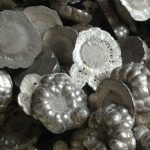Deprecated: get_settings is deprecated since version 2.1.0! Use get_option() instead. in /www/sites/alloy.wiki/index/wp-includes/functions.php on line 4862
Titanium is an inert metal, its chemical symbol is ti, atomic number is 22, and it is a silver metal. The specific gravity is 4.51 and the melting point is 1668°C. Its reserves in the earth’s crust are very rich. It is second only to iron, aluminum, and magnesium, ranking fourth, and more than ten times more than the sum of commonly used metals such as copper, nickel, lead, and zinc.
Industrially used to produce titanium ores are rutile, ilmenite and titanomagnetite. Due to the difficulty of separation and extraction, industrially significant metal titanium was not produced until the 1940s. Therefore, titanium is generally called a rare light metal. Because different products in different fields require different titanium and titanium alloy products, people process them into plates, rods, tubes, ribbons, wires and other shapes that can be deep-processed to meet the needs of different fields. Titanium plates, titanium rings, titanium forgings, etc. are the most widely used. The following shares the specifications and performance of commonly used titanium plates in the chemical industry.
Executive standard: GB/T3621-2007
The surface of the titanium plate should be bright and clean, showing the natural color of metal. Plates are allowed to be delivered with a sandblasted surface. Slight darkening and local water marks are allowed on the surface of the titanium plate; local defects, scratches, indentations, pits and other defects that do not exceed half of the thickness tolerance are allowed, but the minimum thickness should be guaranteed.
The surface is not allowed to have cracks, peeling, oxide scale, crushing, metal and non-metal inclusions and other macro defects and traces of alkaline washing. The titanium plate is allowed to clear the local defects along the rolling direction, but the thickness of the plate after removal is not less than the minimum allowable thickness.
In addition, there should be no delamination of the titanium plate.
Titanium and titanium alloys have low density and high tensile strength. In the range of -253-600 degrees Celsius, its specific strength is almost the highest among metal materials. It can form a thin and hard oxide in a suitable oxidizing environment. The material film has excellent corrosion resistance.
In addition, it is also non-magnetic and has a small linear expansion coefficient. This made titanium and its alloys first become important aerospace structural materials, and then extended to shipbuilding, chemical industry and other fields, and has been rapidly developed.
Especially in the chemical industry, titanium and titanium alloy products are used in more and more products, such as petrochemical, fiber, pulp, fertilizer, electrochemistry and seawater desalination industries, as exchangers, reaction towers, and synthesizers. Autoclave etc.
Among them, the titanium plate is used as an electrolytic plate, an electrolytic cell in the electrolysis and sewage desalination, in the reaction tower, the reaction kettle is used as the tower body and the kettle body, etc.
With the development of science and technology, the application fields of titanium materials are becoming wider and wider, such as medical treatment, automobile, sports, etc. It also truly reflects that titanium, as a light metal, has more and more excellent properties. It is recognized and determined by people, and it will replace other metals into our production and application fields, and even our body at the fastest speed.
Link to this article:The chemical industry's application requirements for titanium plates and titanium alloy plates
Reprint Statement: If there are no special instructions, all articles on this site are original. Please indicate the source for reprinting:Alloy Wiki,thanks!^^


